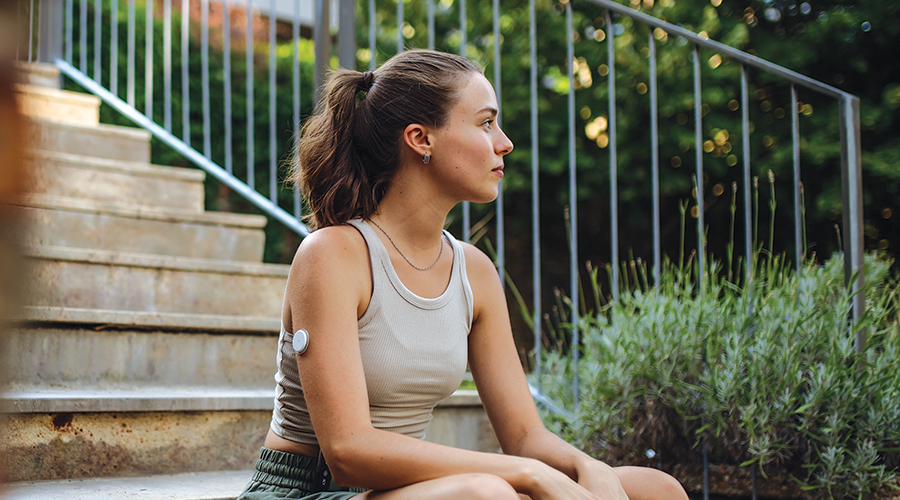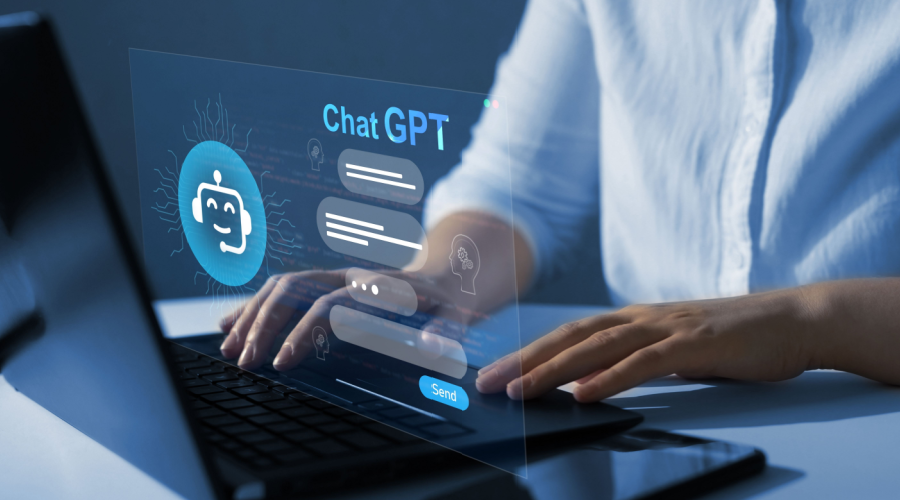The first continuous glucose monitors (CGM) were approved by the U.S. Food and Drug Administration (FDA) in 1999. The first device could record glucose values for three days, and then the information was downloaded in the healthcare provider’s office for the patient to review.
While CGM has been accessible over the past two decades, the most recent trend has been the FDA’s approval of the first over-the-counter (OTC) continuous glucose biosensors (CGM) on March 5. The device is intended for people with type 2 diabetes who don’t take insulin to manage their condition. However, the biosensor can also be used by those without diabetes who simply want to know how their diet and exercise affect their blood glucose levels.
A wearable sensor on the monitor is paired with a smartphone app that measures, records, displays real-time glucose levels, and helps support behavior modification. One of the benefits of the OTC biosensor is that it can help people who need to track their glucose levels but are unable to access a CGM through insurance. What’s more, it also has the potential of undiagnosed diabetes and prediabetes.
For the use of CGM for those using insulin or at risk of hypoglycemia, real-time CGM can help your patients manage their glycemia, and depending on the state you live in, you can practice under medication therapy management (MTM), comprehensive medication management (CMM), or collaborative drug therapy management (CDTM). Also determined by state regulations, pharmacists can prescribe CGM devices based on guideline recommendations and provide adequate training to patients and caregivers.
People with type 2 diabetes who are managing it with oral medications and lifestyle changes might benefit from CGM; especially if they don’t want to stick their finger multiple times a day to check blood sugar.
“There are two components to the product,” said Keri Leone, Sr. Director, Global Medical Affairs with Dexcom. “It comes in a box, and you basically untwist it and pop a sensor on your arm. It literally takes a second to do. Then, in 30 minutes, it warms up and starts reading your glucose. Your glucose can be read to a specific handheld receiver or your smartphone.”
There’s also a feature called Urgent Low Soon. If the feature is turned on, it will tell the patient that their numbers will be low soon, thus reminding them to not take more medicine or to go eat something to avoid a severe hypoglycemic event.
“This feature is unique to Dexcom. It looks at what your glucose is and then predicts if your glucose will be at or below the severe hypoglycemic level (<55mg/dL) in the next 30 minutes. So, if you give yourself too much insulin, that 30 minutes can turn a 150 on its way down quickly,” Leone said. “If it notices you may have a glucose value of 55 or lower in the next 30 minutes, it’ll warn you to eat something. This is the best feature for Medicare patients because sometimes they don’t actually feel the lows because they’ve had diabetes over a longer period. Most of our patients are choosing to use it on their smart device. But for Medicare to cover it, it needs to have a durable aspect, which is the receiver.”
The use of CGM in the management of diabetes has been shown to decrease A1C and can provide much deeper insight into glucose patterns than a single value like a blood glucose meter or A1C level. The ability to gather information about whether a patient’s glucose level is high or low makes it much easier to identify and act upon patterns.
- CMS Documentation Requirements
In Non-insulin Treated Diabetes with Problematic Hypoglycemia
CMS Recurrent Level 2 Hypoglycemic Events
Must document at least one of the following:
- Glucose <54mg/dL; or,
- Classification as level 2 events; or,
- BGM testing log with glucose, 54mg/dL; and,
More than one previous medication adjustment and/or modification to the treatment plan prior to the most recent level two event.
Documentation Needs:
Level 3 Hypoglycemic Event
Must document at least one of the following:
- Glucose <54mg/dL; or,
- Classification as level 3 event; or,
- BGM testing log with glucose, <54mg/dL; and,
Required third party assistance for treatment.
- CGM Accessibility Through Pharmacy and DME Channel
- Centers for Medicare & Medicaid (CMS) classifies CGMs as Durable Medical Equipment (DME), covered under Part B.
- Access: Individuals with FFS Medicare or Medicare Advantage can obtain Dexcom through a durable medical equipment vendor if they meet any insulin criteria and/or experience level 2 or level 3 hypoglycemia.
- Pharmacy Access: Some Medicare Advantage plans, such as the list below, allow access to Dexcom at the pharmacy (still under the medical benefit, not Part D).
- CGM is available for pickup at pharmacies for beneficiaries enrolled in Medicare Advantage plans, such as those provided by United Healthcare, Aetna, Cigna, and Humana—making it easier for patients to get their CGM to send scripts to the pharmacy.
Hypoglycemia can also be dangerous, though many people can be asymptomatic. That’s where CGM can be especially helpful. It can also identify hypoglycemia and alert patients to predicted low glucose levels so they can intervene early to minimize its severity. CGM can also alert patients when their glucose is high. However, if the alert level for hyperglycemia isn’t set appropriately for the patient, it may alert the patient more often. This can be seen as a nuisance. With diabetes, it’s normal to see incidences of hyperglycemia, so setting alerts to a level that’s attainable to the patient is important.
To improve access to CGM and reduce the administrative burden for HCPs to document the need for CGM, on October 1, new ICD-10 codes will come out. So, for pharmacists who code for their time with those patients and get reimbursed, there is going to be a much more effective and efficient way of documenting for those with hypoglycemia.
A collaboration between Dexcom and other entities went to CMS in May and made it known that there wasn’t a great way to document severe hypoglycemia. They asked if they could work together and make it easier for providers, prescribers, and pharmacists to code for these people. The two main brands of CGM that you can now get through CMS are the Abbott Libre 2 or 3 and Dexcom G7.
“CMS approved, and as of October 1st, there will be three codes now instead of having to write it in your notes and then have to submit your notes to CMS for review,” Leone said. “You can just code e16.a1, e16.a2, or e16.a3, and that one code tells CMS this patient has hypoglycemia, severe hypoglycemia, or needs third-party assistance.”
“What’s exciting specifically for Medicare Advantage plans is now they can access CGM through their pharmacy. So, they can get CGM sent right to their local pharmacy. Their pharmacist would have to order the product, but in some cases, the pharmacy carries them on the shelf. Once it’s prescribed, they hand it over to a patient with their copay, which can be through their normal pharmacy channel,” Leone said. “And specifically, with Medicare Advantage plans, like United Healthcare, Aetna, Cigna, and Humana, there is a growing availability through the pharmacy channel, making it easier for patients to get their CGM.”
If you come across patients whose glucose alerts and readings from their CGM don’t match their symptoms or expectations, Dexcom recommends using a blood glucose meter to make their diabetes treatment decisions. You can find a list of compatible devices at dexcom.com/compatibility.
Updated Medicare Coverage Criteria for CGM
Updates to the coverage criteria for CGM allow many more Medicare beneficiaries to qualify.
The patient’s medical record should show they meet the following eligibility requirements:
- Treated with insulin; or
- Documented history of problematic hypoglycemia with at least one of the following:
– Recurrent level 2 hypoglycemic events (glucose <54 mg/dL) that persist despite multiple (more than one) attempts to adjust medication(s) and/or modify the diabetes treatment plan; or
– A history of one level 3 hypoglycemic
event (glucose <54 mg/dL) requiring third-party assistance
(Source: Centers for Medicare and Medicaid Services, LCD)
More articles from the December 2024 issue:
- Diagnosing Alzheimer’s Disease
- Patient Medication Reviews
- A New Direction for Continuous Glucose Monitors
- The Prevalence of Osteoarthritis
- Vaccine Overview 2024-25
- Peripheral Artery Disease
- PBMs Exposed
- Cybersecurity in Your Pharmacy
A Member-Owned Company Serving Independent Pharmacies
PBA Health is dedicated to helping independent pharmacies reach their full potential on the buy-side of their business. Founded and run by pharmacists, PBA Health serves independent pharmacies with group purchasing services, wholesaler contract negotiations, proprietary purchasing tools, and more.
An HDA member, PBA Health operates its own NABP-accredited warehouse with more than 6,000 SKUs, including brands, generics, narcotics CII-CV, cold-storage products, and over-the-counter (OTC) products — offering the lowest prices in the secondary market.












